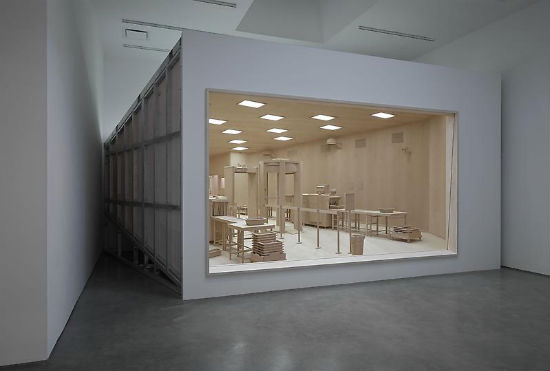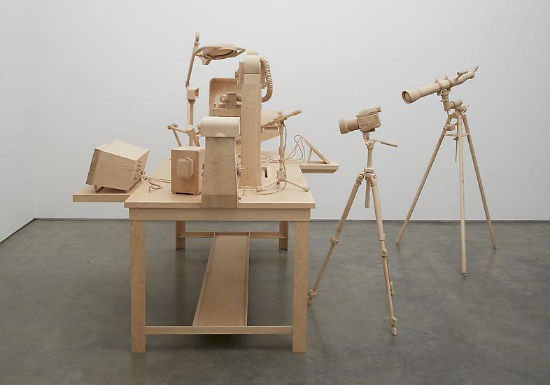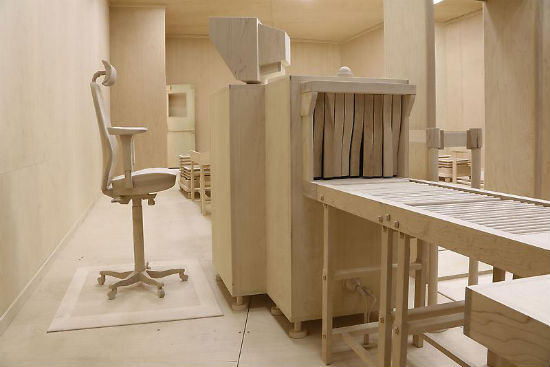artcritical
by David Brody
Denuded Lens: Roxy Paine at Marianne Boesky
Sculpture once had no other task than to render convincing simulacra of passing phenomena in permanent materials. If this is “familiar conceptual territory,” as Ken Johnson wrote in his New York Times review of Roxy Paine’s current exhibition at Boesky, all the more impressive is Paine’s relentless, scrupulous, and highly personal exploration of it. Superstars from Ai Wei Wei to Jeff Koons are using sculptural substitution effectively, if indeed familiarly, with herds of lesser lights toiling in the genre. But for more than 20 years, Paine has been digging deep: his abiding interest is in how the ideal transformation from one material into another is achieved, and why the artist’s physical touch keeps hanging around as part of the answer. On the one hand, Paine has painstakingly hand-crafted botanical portraits of astounding variety and detail, and on the other, he has engineered machines that produce gorgeous, or in some cases intentionally grotesque, sculptures, paintings and drawings, works whose authorship is thus unstable. Paine is both the John Henry of contemporary art and the machine against which he is racing.
Paine’s art-making machines were only slightly more beautiful than they needed to be. With the new work, seductive landscapes of surveillance instruments, tools and equipment carved with uncanny precision from buttery maple, Paine circles back to ponder the machine aesthetic, this time more explicitly. At least, there can be no functional argument for the solid wood valves and circuitry of his new sculptures, collectively titled Denuded Lens. But aesthetics are never neutral, and here Paine’s close-to-the-vest hyperrealism invokes the bewitching taxidermies of lost wilderness found in natural history museums – along with their inadvertent prophecy.
The largest piece in the show, Checkpoint (all works 2014) is a full-scale AMNH-style diorama of a typical airport security set-up. It is the third in a new body of work that freeze-dries contemporary workplaces, absent its humans. The previous two dioramas (shown at Kavi Gupta in Chicago) depicted idealized, pristine replicas of a power plant control room and a fast food restaurant – all of these rooms are prisons of a kind. Sterile and still, the only trace of movement in Checkpoint are the rubber flaps of the luggage belts arrested stiffly in mid-bend, as if they’d settled that way years before. The ensemble carries a skewed perspective through every object along the architectural grid, including ceiling tiles with functioning fluorescents (the only objects in the exhibition rendered in a material other than wood). Checkpoint’s subtle, easily-swallowed perspective distortion is a feat of visual remapping that artists from Hans Holbein to Robert Lazzarini have used to diverse ends. Paine has said that he was alluding to the spatial –and informational – compression of clandestine snapshots, from which the ghostly scene was, in part, synthesized. Maybe he was also thinking of the anamorphically skewed skull hidden in Holbein’s The Ambassadors. Certainly viewers will have no trouble finding a memento mori in this chilling portrait of public space askew.
In the smallest work in the show, a hand-held bullhorn is seamlessly engineered onto the back of a chain saw – again, as modeled in blond maple at actual size, down to tiny dowel pins along the chain of the blade. To fire up the bullhorn, whose electric power supply is implicitly grafted to the chainsaw’s gas motor, you have to fire up the blade, thus drowning out speech with amplified brute noise. In any event blade and horn face opposite directions, so leaning in to speak would be suicidal. An image of this angry object, however double-edged, would work perfectly as a political cartoon – say, above an Op Ed piece about bullying tactics by lumber company lobbyists. Paine’s title, Speech Impediment, even provides the caption.
If Speech Impediment and Checkpoint are moralistic in tone, other works in the show are more cryptic. Machine of Indeterminacy and Scrutiny are elaborate, imaginary conflations of scientific-industrial apparatus, with exposed tubing and non-consumer interfaces that call to mind Paine’s own art-making machines. A central irony of the current sculptures is that many viewers will assume they are simply spit out of a 3-D scan like the myriad luxury readymades now ubiquitous at art fairs. You have to look closely, and know something of this artist’s extensive record, to decipher the conflation of hand and machine in Paine’s sculpting. As always, precisely where hand begins and machine ends is very much the question – especially since Paine is no civilian when it comes to computer-controlled carving: ten years ago he custom-built his own Erosion Machine (2005), which turns thick slabs of stone into mini-Bryce Canyons. That precision sandblaster, implementing statistical data sets, produced a more convincing facture than the “computery” striations of commercially available cutters and extruders executing 3-D digital files.
Theoretically Erosion Machine could go on making gorgeous carvings forever –– thus “eroding” labor-value in art. On the other hand, it might take a hundred years of production to pay back Paine’s Herculean investment in his one-of-a-kind prototype . A bipolar take on labor is visible in the very woodgrain of these new sculptures. In Scrutiny, amid a threatening omnigatherum of investigative instruments from telescope to voltage meter, a humble pencil rests on a notepad. The contrasting grains show that pencil and pad were carved independently and then joined. Follow the grain through the five works, as you resist the urge to touch the tiny valve wheels, toggles, keyboards and knobs, and you become alert to the situational carving and carpentering of every detail. At the same time you begin to realize that, despite their seeming exhaustiveness, Paine’s compositions are never too detailed. Rather, they are pruned and arranged with Poussin-like discipline. “Machine of Indeterminacy,” with its elegant contrasts of orthogonal housing, spiraling screw blade, and pliant tubing, is a kind of Arcadia. It has no logic as a machine, only as ideal landscape.
Where Paine does use a computer router, its characteristic texture is purposeful: in a wrinkly garbage bag in Checkpoint, which only heightens the lifelessness of the scene; and in the rock faces that replace a pinball machine’s playing and scoring boards in Intrusion. Here the artificial look of the rock, which is emphasized by stripes of wood lamination, adds to the Magrittean enigma: is it modeled on genuine igneous intrusion or on a faux-rock climbing wall? Either way, the urge to pull the plunger and launch a ball is palpable. An especially synthetic gulley begs for a wayward pinball to spiral into its too-smoothly rounded contours. In vain one checks one’s pockets for a perfectly notched and faceted maple quarter.
October 2014


